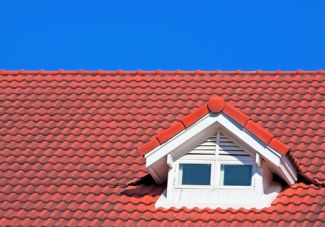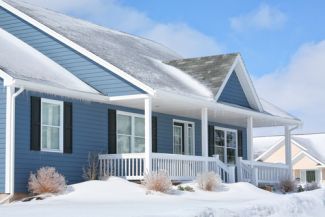Avoiding Roof Problems
Keep Your Roof In Good Condition

It is important to monitor the physical condition of your home's roof regularly, so that you spot problems early, before they compound into serious issues. Do not wait until a leak occurs. Instead, be proactive – inspect your roof at least twice per year and also after heavy storms. When you see signs of roof damage, have a professional repair them immediately.
You can probably accomplish a portion of your visual roof inspection from the ground, using binoculars. However, it is necessary to go up on the roof for a close-up view from time to time as well. Be sure to exercise caution when on your roof or climbing on ladders to avoid injury, and stay off your roof during slippery conditions. Alternatively, you can have a roofing professional help you inspect your roof.
In general, to maintain a healthy roof, ensure that your roofing material and flashing are water tight and in good shape. Also make sure your attic has good ventilation and insulation. If one of these basic elements of your roofing system is deficient, your roof's integrity is compromised, which will lead to problems.
Keep in mind that the climate conditions in your area will have a dramatic effect on your roof's longevity. Harsh precipitation, such as hail, will cause significant wear to your roof over time, as will air that has a high salt or pollutant content. Wind is another important factor. High winds push and tug at the edges and top of your roof. Over time this can cause your shingles, and the roof frame itself, to loosen.
Inspecting Your Roof
 Check your roof for damaged or missing shingles. When shingles deteriorate or are missing, the roofing material below is exposed to the elements, causing water damage. Watch for pieces of shingles in your gutters or in the yard around your house.
Check your roof for damaged or missing shingles. When shingles deteriorate or are missing, the roofing material below is exposed to the elements, causing water damage. Watch for pieces of shingles in your gutters or in the yard around your house.
Look at the metal flashing that is attached to your chimneys, vent pipes, and roof joints. Leaks can occur when this flashing is damaged. On large, complex roofs, look at the valleys connecting your roof's different surfaces. These valleys serve as primary pathways for water, funneling it to a particular spot as it exits the roof. Because of their importance, these valleys are often reinforced by an extra "snow and ice shield" protective layer underneath the roofing. Make sure that all of the roofing materials in these valleys are in good shape, since a puncture here could quickly lead to serious water damage.
Hail can be especially damaging to a roof. After a big hail storm, once your roof is no longer slippery, look for signs of damage to your roof. On your shingles, check for a repeating pattern of dents or broken edges and corners. If you have asphalt shingles, look for eroded asphalt particles in your gutters. Also, be on the lookout for leaks after a hailstorm, as the hail could have actually punctured your roof.
Inside Your House
Walk through your house, and look for any signs of water leaking through your roof, including water-stained ceilings or walls, as well as peeling wallpaper.
Ice Dams
 One common problem in areas with cold winters is "ice damming." This takes place when snow or ice melts and then freezes again as temperatures drop, creating a dam of ice. As some of the ice then melts, water gets trapped by the dam, resulting in standing water on your roof. If there happens to be faulty roofing material where that water collects, water can end up entering your house, causing a serious problem. Additionally, the ice itself can damage your roofing material by freezing and thawing while attached to your shingles. Because of this, try to verify whether the lowest sections of your roof are protected by a "snow and ice shield" layer.
One common problem in areas with cold winters is "ice damming." This takes place when snow or ice melts and then freezes again as temperatures drop, creating a dam of ice. As some of the ice then melts, water gets trapped by the dam, resulting in standing water on your roof. If there happens to be faulty roofing material where that water collects, water can end up entering your house, causing a serious problem. Additionally, the ice itself can damage your roofing material by freezing and thawing while attached to your shingles. Because of this, try to verify whether the lowest sections of your roof are protected by a "snow and ice shield" layer.
Ventilation and Insulation
The root cause of ice damming is usually insufficient attic ventilation or insulation, which allows the attic, and subsequently the roof, to get too warm. Generally, winter attic temperatures should only be a few degrees warmer than the outside temperature. People often do not realize this and allow their attics to get too warm. Heat then passes through the attic to the roof, causing ice dams and standing water problems.
 Attic condensation and moisture also affect your roof. Condensation is the unavoidable byproduct of "hot meeting cold." Similar to the way a cold drink in a hot room produces moisture on the outside of the glass, condensation is continuously occurring inside your attic insulation layer, since the insulation is the barrier between hot and cold temperatures. This moisture needs to be carried away from your attic by a well-functioning air circulation system. If it is not removed, then during warm months, heat and moisture will break down your roofing material, causing it to wear out prematurely. Additionally, in the wintertime, condensation will saturate your insulation, reducing its ability to insulate and leading to high attic temperature problems.
Attic condensation and moisture also affect your roof. Condensation is the unavoidable byproduct of "hot meeting cold." Similar to the way a cold drink in a hot room produces moisture on the outside of the glass, condensation is continuously occurring inside your attic insulation layer, since the insulation is the barrier between hot and cold temperatures. This moisture needs to be carried away from your attic by a well-functioning air circulation system. If it is not removed, then during warm months, heat and moisture will break down your roofing material, causing it to wear out prematurely. Additionally, in the wintertime, condensation will saturate your insulation, reducing its ability to insulate and leading to high attic temperature problems.
To protect your attic and roof from heat and condensation, check to make sure your soffit intake vents and ridge vents are not blocked. A soffit is the underside of your roof's overhang. Vents are usually located there, because it is a natural place from which to draw cool air into your attic. It is essential to your roof's health that these vents are open, because if they do not vent properly, heat and condensation problems will likely occur. Since warm air rises naturally, it will seek to exit out of your roof's ridge vent, located at the highest point in your roof. This subsequently causes fresh, cooler air to be drawn into your attic through the soffit vents. This basic air circulation pattern should operate continuously to keep your attic and roof from getting too hot, while also carrying away excess moisture and keeping your insulation dry, so it insulates properly.
Remove anything that might be blocking your soffit and ridge vents, such as insulation stuffed against them or possibly wood that was installed in front of them, in a misguided attempt to keep the attic warm. Additionally, consider adding an attic fan to dispel excess heat from your attic in the summer. An attic fan is minimal expense, but it can greatly increase the effectiveness of your soffit and ridge vent system. Also, consider adding insulation baffles between each rafter or roof truss, if they are not already installed, as this is another inexpensive way to promote air flow through your soffit vents.
Proper attic insulation is another important component of a healthy roof. As mentioned above, you actually want the unused attic portion of your house to be cold during the winter, like the outside air. Many people try to keep their attics warm as a way to keep heating costs down, but this is actually counterproductive.
A simple way to tell if your attic floor has enough insulation, and if your attic vents are working properly, is to look at your roof during cold weather when snow covers it. Monitor the amount of snow on the roof for a few days. If the snow stays on your roof, it is likely that your ventilation and insulation are sufficient, but if the snow melts quickly on certain parts of your roof, you can tell that either your insulation or venting is lacking in those spots. Also, it is important to make sure your attic insulation is of an appropriate thickness, or "R value" for your geographic location. Consult your local building codes or a home construction professional to make this determination.
Perform Regular Maintenance and Fix Problems Quickly
 Finally, make sure you continually monitor your roof's condition and perform regular maintenance. One simple step you can take is to just keep your roof clean. This is especially important for homes with minimally sloped roofs. Sweep debris off your roof, while taking care not to damage your shingles in the process. Also, keep your gutters well maintained. Properly functioning gutter drainage is very important to your roof's health and also helps to prevent basement water damage by leading rain water away from your foundation (read gutter cleaning). Most importantly, when you do spot roof damage, get it fixed as soon as you can, so it does not turn into a more serious issue in the future.
Finally, make sure you continually monitor your roof's condition and perform regular maintenance. One simple step you can take is to just keep your roof clean. This is especially important for homes with minimally sloped roofs. Sweep debris off your roof, while taking care not to damage your shingles in the process. Also, keep your gutters well maintained. Properly functioning gutter drainage is very important to your roof's health and also helps to prevent basement water damage by leading rain water away from your foundation (read gutter cleaning). Most importantly, when you do spot roof damage, get it fixed as soon as you can, so it does not turn into a more serious issue in the future.
At some point every roof does reach the end of its life span. For further reading, check out our articles on how to tell if you need a new roof and how to estimate roof costs.
Image source: aidanmorgan
 The Avoiding Roof Problems by Water Damage Defense, is licensed under a Creative Commons Attribution-ShareAlike 3.0 Unported License.
The Avoiding Roof Problems by Water Damage Defense, is licensed under a Creative Commons Attribution-ShareAlike 3.0 Unported License.
